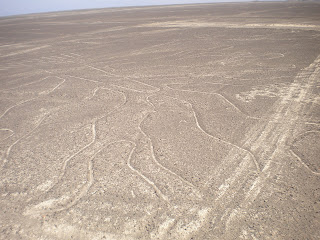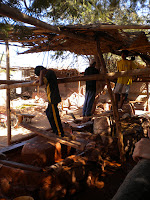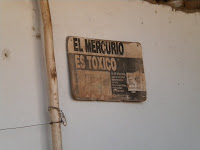Because of the lack of rain the Nazcas dug grand aqueducts some 1500 years ago to reach the ground water. These circular pathways led to the wells which were slowly becoming deeper from the sloped ground.
In between the aqueducts and the Nazca lines we learned how gold is mined and how pottery is made in the town of Nazca. In the mountains the rocks are first tested for gold by panning. Those that contain gold are then carried 1-2 km to the extraction area. Next the rock is ground into dust which is put in a tank with water and mercury. For 5-6 hours the miner mixes the concoction with a giant rock he stands on. Through the mixing the water and other minerals are sieved and collected in a separate tank. As the mercury sticks to gold, these two elements remain and are further refined by squeezing through a fine silk. Now the combined mercury and gold are put in a vaporizer and heated to separate the mercury for later use.
At the point the process is finished and the miner has his prize: 1oz. of gold which fetches a price of about $40. This hefty price tag earns a miner more in a week than most earn in a month, despite the difficulty and risk involved.
The pottery demonstration seemed very routine as in other countries where the dirt is mixed with water to form clay which is formed into shapes. Next the ceramics are left in the sun to set and afterwards are polished with water before being painted with baby hair paint brushes. We were told with a smile that because babies have such fine hair it is best for making brushes. Next oil from the potter's skin and hair shines up the art before a makeshift kiln finishes the process.
We finished our tour of Nazca with a look at the ruins of an Incan municipal building built in the 1450s. Here we observed the stone-on-stone walls and rectangular windows characteristic of Incas. The municipal area had a prison, hotel and stores and provided a clear view of the valley, necessary for the safety of the community.
Returning to Ica we grabbed dinner and snacks before the 4hr ride back to Lima. Host families tomorrow!
Lessons Learned:
- Cacti are grown near the aqueducts not for food but as a habitat for bugs that are harvested as a fertilizer. Speculated to be Red Dye #40?
- Women miners are rare because of the difficult work, and also an old myth that women in mines makes all the gold disappear.
- The Nazcas were smart enough to the Nazca lines says Miguel, no aliens needed!








No comments:
Post a Comment